In an era defined by climate change, environmental consciousness and sustainable living, its crucial to implement innovative solutions to address our impact on the planet. Campaigns such as the Living Building Challenge, which promotes carbon neutral projects & sustainable building practices & Australia’s Green Star Rating system further incentivizes environmentally responsible construction. In this blog post, we’ll delve into the significance of carbon neutral projects, explore the Living Building Challenge and Green Star Rating system.
The Necessity of Carbon Neutral Projects
Carbon neutrality is the holy grail of sustainable projects. Achieving carbon neutrality means that total greenhouse gas emissions produced are balanced by the removal or offsetting of an equivalent amount of emissions from the atmosphere. This equilibrium is critical for mitigating climate change and safeguarding the environment for future generations. Carbon neutral projects not only reduce our carbon footprint but also serve as a model for a more sustainable and eco friendly future.
The Living Building Challenge: Pioneering Sustainable Design
The Living Building Challenge, established by the International Living Future Institute, stands at the forefront of sustainable design. It’s a rigorous certification program that inspires architects, designers and builders to push the boundaries of sustainable construction. The Challenge calls for projects that operate with zero net energy, are water self sufficient and free from toxic materials. One of it most profound goals is to create buildings that are ‘regenerative’ rather than merely sustainable. In other words, buildings that give back to the environment by improving ecological health. Living Building Challenge projects often serve as a testament to what is possible when we prioritise environmental responsibility in the design and construction phase.
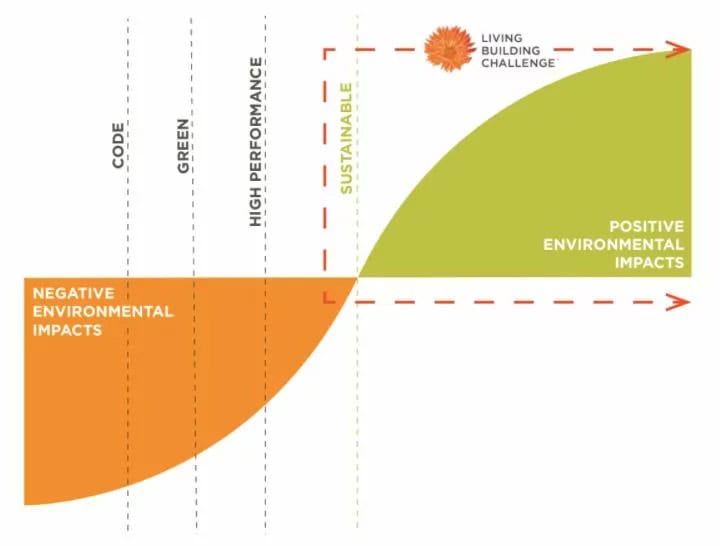
Australia's Most Sustainable Building
The University of Wollongong’s Sustainable Buildings Research Centre (SBRC) has achieved full marks under the world’s toughest sustainability standard for buildings, the Living Building Challenge (LBC). The result confirms that the SBRC building has set a new benchmark as arguably the most sustainable building in Australia.
The LBC, administered by the International Living Future Institute (ILFI), certifies projects that meet ambitious green building performance standards through a framework of “Petals” around categories that include Energy, Materials, and Water. “Living” Certified buildings have met the criteria for all seven petals. There are only 24 buildings in the world that have met all seven Petals and are considered Living Certified; an exclusive list that now includes the SBRC.
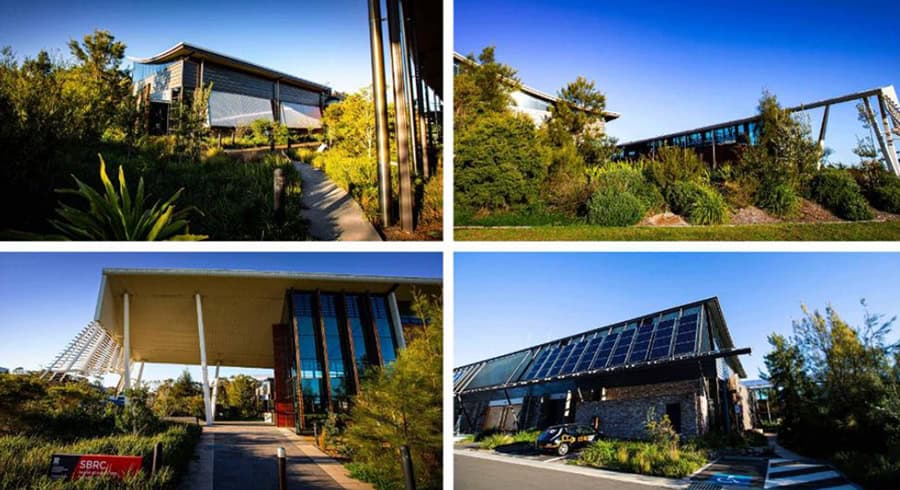
Green Star Ratings: Measuring Environmental Impact
In Australia, the Green Building Council of Australia (GBCA) offers a Green Star Rating system to evaluate the environmental performance of buildings. This system awards ratings from 1 to 6 stars, with 4+ stars indicating exceptional levels of sustainability. These stars reflect various aspects of environmentally conscious construction, including energy efficiency, water conservation, indoor air quality and materials used. The higher the Green star rating, the more eco-friendly and sustainable the building is considered to be.
★★★★ - signifies a 'Best Practice' level of sustainability
★★★★★ - indicates 'Australian Excellence' in sustainability
★★★★★★ - the highest achievable and is an emblem of 'World Leadership' in environmentally responsible building
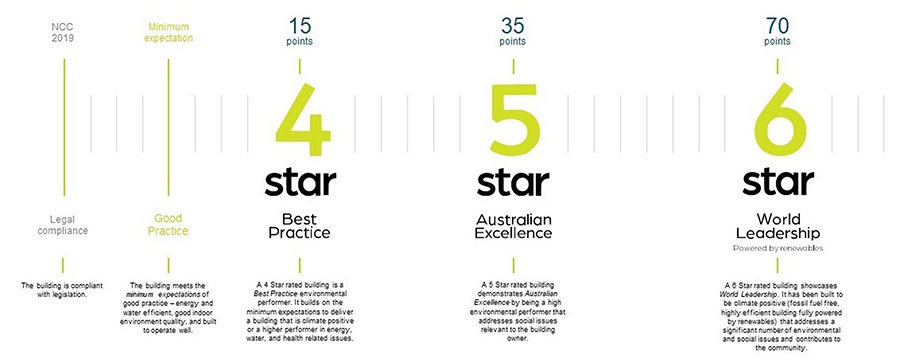
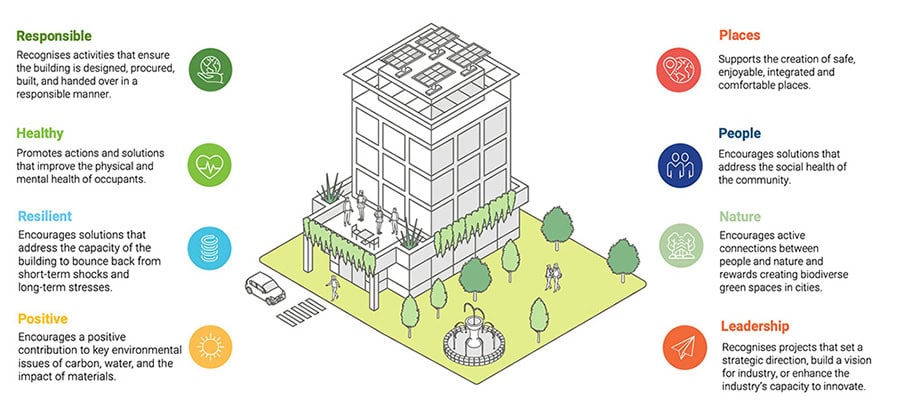
Sydney Opera House: A World Leading Sustainability Performance
The Sydney Opera House, an iconic architectural marvel, has indeed achieved an impressive 6-star Green Star Rating for “world leadership” in 2023. This remarkable upgrade from a 4-star Green Star Performance rating to a 6-star rating is a testament to the Opera House’s unwavering commitment to environmental sustainability. Through a series of comprehensive sustainability initiatives, it has drastically reduced energy consumption, curbed greenhouse gas emissions, and actively championed water conservation and responsible waste management. The Sydney Opera House’s achievement of a 6-star Green Star Rating places it at the pinnacle of environmental responsibility, setting an exemplary standard for iconic structures worldwide.

NABERS: A Key Player In Australia's Green Building Movement
Alongside the Living Building Challenge & Green Star Rating, the National Australian Built Environment Rating system (NABERS) is a highly influential and nationally recognized initiative in Australia. It focuses on assessing and rating the environmental performance of buildings and tenancies, using a comprehensive evaluation system that takes into account factors such as energy usage, water efficiency, indoor air quality and waste management. This program offers a practical and user friendly framework for building owners and tenants to measure and improve the sustainability of their premises. With NABERS, it becomes easier to make informed choices and track the environmental impact of commercial spaces, further encouraging the adoption of sustainable practices in the construction and real estate sectors. Together, the Living Building Challenge, Green Star Ratings and NABERS are contributing to a more sustainable built environment in Australia and are key drivers of positive change in the industry.
Jonite Stone Products: A Beacon of Carbon Neutrality
Jonite, a company that specializes in innovative stone products is a great option for carbon neutral & sustainable projects. Jonite stone products are celebrated for their carbon friendly & sustainable qualities, making them an eco-conscious choice for sustainable projects. The company has leveraged its resources and expertise to craft products that are exceptionally sustainable & aesthetically pleasing.
The stone range is thoughtfully engineered from recycled materials designed to withstand the test of time thereby reducing the necessity for replacements or repairs, minimising waste and resource consumption. Additionally, their manufacturing process is committed to energy efficiency further diminishing their environmental impact. Notably, the Jonite range does not contain any red-listed materials from the International Living Future Institute’s Material Red List. This dedication to avoiding harmful substances perfectly aligns with the objectives of environmentally conscious projects and the Green Star Rating system, making Jonite a standout choice for sustainable construction projects.
Jonite is the only grates manufacturer to be a leader with four ticks under the SGBC (Singapore Green Building Council) Architectural Drain Covers category amongst other recognitions worldwide. These stamps of sustainability are awarded only to companies with leading practices such as recycling content, avoidance of hazardous substances, low carbon footprint and proper implementation of waste, water and energy management.

SGBC
The four-ticks highest accolade is awarded based on a strict standard of green features. This accreditation enables architects to receive higher BCA Green Mark points.

Green Label
The Green Label by the Singapore Environment Council is awarded to companies for their use of environmentally friendly products that adhere to the highest international eco-standards.
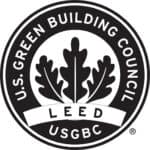
LEED
Jonite is a member of the U.S. Green Building Council (USGBC) with the MR Credit 4: Recycled Content under the LEED® Green Building Rating System benchmark high-performance green buildings in the United States.
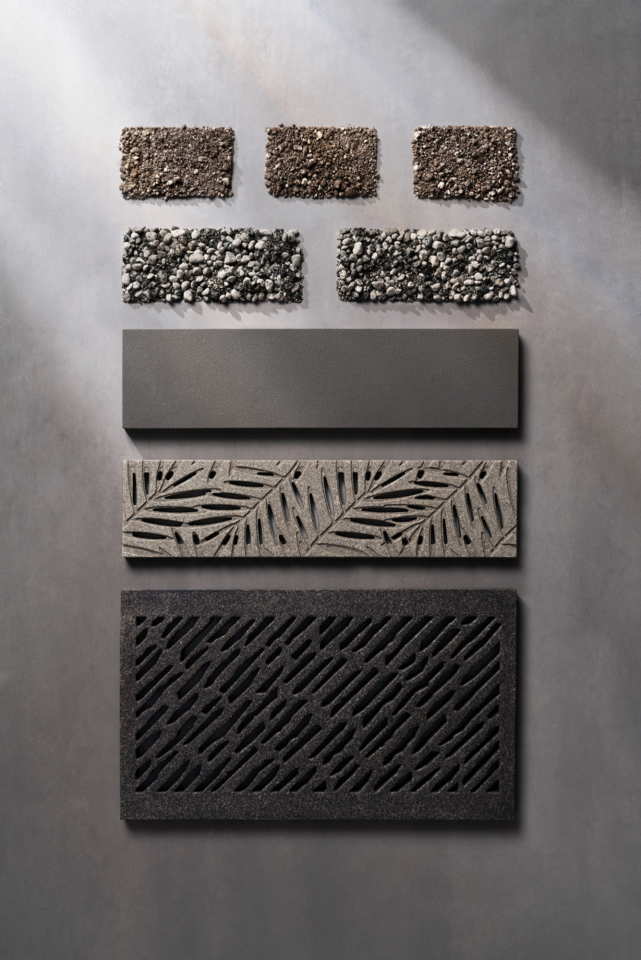
Ever Green. By Design
Made from Nature
Jonite goes the distance to ensure their grates are made of at least 95% natural aggregates and only 5% hybrid polymers – for stone aesthetics that delight architects and the planet
Made to Measure
The four-ticks highest accolade is awarded based on a strict standard of green features. This accreditation enables architects to receive higher BCA Green Mark points.
LEED
All Jonite products are proudly made of at least 30% recycled materials. And they are not stopping, research & development is a big part of their daily process to ensure the brand continues to become even more sustainable.
Footprints Made Friendlier
By making a conscious choice not to use cast iron, Jonite has reduced steel in their products by up to 80%, which in turn has significantly decreased their carbon footprint by more than 16x
Here to Stay
Installed as intended. Jonite products are designed to last a lifetime. With the only stone composite that takes loads the way cast iron or steel does, Jonite is heavy duty, low water absorption, corrosion and rust resistant = sustainable for life
In conclusion, the Living Building Challenge, Green Star Ratings, and eco-friendly projects are integral components of a more sustainable and environmentally aware future. They encourage us to revolutionise our approach to construction, inspiring us to create structures that not only meet our needs but also safeguard our planet. Jonite’s sustainable stone products are emblematic of the growing industry-wide commitment to environmental responsibility. By continuing to embrace these principles, we can construct a greener, more sustainable future for all.